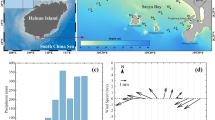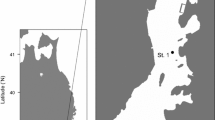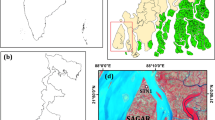Abstract
On 11 March 2011, the Sanriku coast of Japan was struck by a massive tsunami associated with the 2011 off the Pacific coast of Tohoku Earthquake. The tsunami caused large disturbances in bottom sediments and severe destruction of human-made structures, natural landscapes and infrastructures such as sewage treatment systems and aquaculture facilities. A serious and continuing concern is a fundamental alteration of the nutrient regime in the impacted regions, which may exert a profound influence on the processes of ecosystem recovery and fishery reconstruction. We investigated the nutrient status of the water column of Otsuchi Bay, a small embayment that was heavily damaged by the tsunami. Our data collected between May 2011 and July 2014 revealed some prominent features in nutrient parameters that were potentially linked to effects of the tsunami. These features include (1) high turbidity and high concentrations of nitrite and silicic acid until September 2011, (2) the spread of seawater characterized by high phosphate concentration and low total inorganic nitrogen (ammonium + nitrate + nitrite) to phosphate (TIN/P) ratio during the mixing period between November 2011 and January 2012, and (3) an increase in the TIN/P ratio during the mixing period of subsequent years to become higher than it was before the earthquake. These data not only provide evidence of the alteration and subsequent recovery of the nutrient status of Otsuchi Bay after the earthquake but also suggest a possible tsunami-induced alteration in nutrient stoichiometry which appeared to last until at least the beginning of 2014.










Similar content being viewed by others

References
Anbo A, Otobe H, Takagi M (2005) River water flowing into Otsuchi Bay. Otsuchi Mar Res Cent Rep 30:4–8 (in Japanese)
Anderson DM, Glibert PM, Burkholder JM (2002) Harmful algal blooms and eutrophication: nutrient sources, composition, and consequences. Estuaries 25:704–726
Arii M, Koiwa M, Aoki Y (2014) Applicability of SAR to marine debris surveillance after the Great East Japan Earthquake. IEEE J Sel Top Appl Earth Observation Rem Sens 7:1729–1744
Armstrong FA, Stearns CR, Strickland JDH (1967) The measurement of upwelling and subsequent biological processes by means of the Technicon Autoanalyzer II and associated equipment. Deep Sea Res 14:381–389
Burgin AJ, Hamilton SK (2007) Have we overemphasized the role of denitrification in aquatic ecosystems? A review of nitrate removal pathways. Front Ecol Environ 5:89–96
Cloern JE, Foster SQ, Kleckner AE (2014) Phytoplankton primary production in the world’s estuarine-coastal ecosystems. Biogeosciences 11:2477–2501
Coelho SM, Rijstenbil JW, Brown MT (2000) Impacts of anthropogenic stresses on the early development stages of seaweeds. J Aquatic Ecosyst Stress Recovery 7:317–333
Fukuda H, Ogawa H, Sohrin R, Yamasaki A, Koike I (2007) Sources of dissolved organic carbon and nitrogen in Otsuchi Bay on the Sanriku ria coast of Japan in the spring. Coast Mar Sci 31:19–29
Furuya K, Takahashi K, Iizumi H (1993) Wind-dependent formation of phytoplankton spring bloom in Otsuchi Bay, Ria in Sanriku, Japan. J Oceanogr 49:459–475
Gordon LI, Jennings JC, Jr, Ross AA, Krest JM (1993) A suggested protocol for continuous flow automated analysis of seawater nutrients. In: WOCE Operation Manual. WHP Office Report 90-1, WOCE Report 77, 68/91: 1–52
Goto K, Ikehara K, Goff J, Chagué-Goff C, Jaffe B (2014) The 2011 Tohoku-oki tsunami—three years on. Mar Geol 358:2–11
Hanawa K, Mitsudera H (1987) Variation of water system distribution in the Sanriku coastal area. J Oceanogr Soc Jpn 42:435–446
Harrison PJ, Hurd CL (2001) Nutrient physiology of seaweeds: application of concepts to aquaculture. Cah Biol Mar 42:71–82
Hattori A (1976) Distribution of nutrients and chlorophyll of Otsuchi Bay. Otsuchi Mar Res Cent Rep 2:2–5 (In Japanese)
Hattori A (1977a) Distribution of nutrients and chlorophyll of Otsuchi Bay. Otsuchi Mar Res Cent Rep 3:10–11 (In Japanese)
Hattori A (1977b) Distribution of nutrients and chlorophyll of Otsuchi Bay. Otsuchi Mar Res Cent Rep 3:30–33 (In Japanese)
Hattori A (1978a) Distribution of nutrients and chlorophyll of Otsuchi Bay. Otsuchi Mar Res Cent Rep 4:12–13 (In Japanese)
Hattori A (1978b) Distribution of nutrients and chlorophyll of Otsuchi Bay. Otsuchi Mar Res Cent Rep 4:47–48 (In Japanese)
Hattori A, Fujita Y, Wada E, Ohwada K, Iizumi H, Saino T (1974) Survey of water quality. Otsuchi Mar Res Cent Rep 1:43–46 (In Japanese)
Hecky RE, Kilham P (1988) Nutrient limitation of phytoplankton in fresh-water and marine environments— review of recent-evidence on the effects of enrichment. Limnol Oceanogr 33:796–822
Heisler J, Glibert PM, Burkholder JM, Anderson DM, Cochlan W, Dennison WC, Dortch Q, Gobler CJ, Heil CA, Humphries E, Lewitus A, Magnien R, Marshallm HG, Sellner K, Stockwell DA, Stoecker DK, Suddleson M (2008) Eutrophication and harmful algal blooms: a scientific consensus. Harmful Algae 8:3–13
Holmes RW (1970) The Secchi disk in turbid coastal waters. Limnol Oceanogr 15:688–694
Holm-Hansen O, Lorenzen CJ, Holmes RW, Strickland JDH (1965) Fluorometric determination of chlorophyll. ICES J Mar Sci 30:3–15
Howarth RW (1988) Nutrient limitation of net primary production in marine ecosystem. Annu Rev Ecol 19:89–110
Iwate prefecture (2013) Document of the Great East Japan earthquake tsunami in Iwate prefecture. Iwate prefecture. (in Japanese)
Iwate prefecture (2014) Report of the restoration of the disaster-affected sewer facilities in Iwate prefecture. Iwate prefecture Home page. Download from http://www.pref.iwate.jp/toshigesui/gesui/jigyou/008577.html. (in Japanese)
Jianlong W, Ning Y (2004) Partial nitrification under limited dissolved oxygen conditions. Process Biochem 39:1223–1229
Kamaishi city (2011) Disaster waste treatment plan. Kamaishi City, Kamaishi City (in Japanese)
Kamykowski D, Zentara S-J (1991) Spatio-temporal and process-oriented views of nitrite in the world ocean as recorded in the historical data set. Deep Sea Res 38:445–464
Kasai S, Kobayashi M (2012) Picture archives of the outbreak of medically important pest insects in Tsunami affected areas in Tohoku District, Japan. Med Entomol Zool 63:59–69 (in Japanese with English abstract)
Kasai H, Saito H, Yoshimori A, Taguchi S (1997) Variability in timing and magnitude of spring bloom in the Oyashio region, the western subarctic Pacific off Hokkaido, Japan. Fish Oceanogr 6:118–129
Kazama M, Noda T (2012) Damage statistics (Summary of the 2011 off the Pacific Coast of Tohoku Earthquake damage). Soils Found 52:780–792
Knowles R (1982) Denitrification. Microbiol Rev 46:43–70
Levitus S (1982) Climatological Atlas of the World Ocean. NOAA Professional Paper No. 13, U.S. GPO, Washington, DC
Lomas MW, Lipschultz LF (2006) Forming the primary nitrite maximum: nitrifiers or phytoplankton? Limnol Oceanogr 51:2453–2467
Ministry of Land, Infrastructure, Transport and Truism of Japan (2011) Restoration process of sewer processing facilities on 29 November 2011. Ministry of Land, Infrastructure, Transport and Truism of Japan Home page. Download from http://www.mlit.go.jp/common/000186536.pdf. (in Japanese)
Ministry of the Environment of Japan (2014) Result of the estimation of the total amount (gross weight) of marine debris washed up by the March 11 Earthquake. Ministry of the Environment of Japan Home page. Download fromhttp://www.env.go.jp/en/headline/headline.php?serial=1738. (in Japanese with English abstract)
Mori N, Takahashi T, Yasuda T, Yanagisawa H (2011) Survey of 2011 Tohoku earthquake tsunami inundation and run-up. Geophys Res Lett 38: L00G14. doi:10.1029/2011GL049210
Naiki K, Yamada M, Kaga S, Watanabe S, Kamiyama T, Kado R, Ogata T, Nanba N, Hayashizaki K, Yamada Y, Yamashita T (2015) Spatial and temporal variation of sediment properties along the coast of Sanriku district, Iwate prefecture by the tsunami generated by Great East Japan Earthquake in 2011. Nippon Suisan Gakkaishi 81:447–455 (in Japaese with English abstract)
Nishi T, Yagi H, Kamiyama T, Sugimatsu K, Hayashi K, Nakayama A (2013) Change of bottom environment in estuaries of Sanriku by Tohoku Earthquake tsunami. J Jpn Soc Civ Eng Ser B2 69:286–290 (in Japanese with English abstract)
Ogasawara T, Matsubayashi Y, Sakai S, Yasuda T (2012) Characteristics of the 2011 Tohoku Earthquake and Tsunami and Its Impact on the Northern Iwate Coast. Coast Eng J 54: doi:10.1142/S0578563412500039
Okayasu A, Shimozono T, Yamazaki H, Ngai T, Sato S (2013) Severe erosion of sandbar at Unosumai River mouth, Iwate, Due To 2011 TOHOKU Tsunami. Proceedings of Coastal Dynamics 2013. Arachon, France, pp 1311–1320
Okuda K, Ohashi M (2012) On the Studies of Recovery and Reconstruction of Fisheries Hit by the Great East Japan Earthquake. Procedia Tech 5:208–214
Otobe H, Onishi H, Inada M, Michida Y, Terazaki M (2009) Estimation of water circulation in Otsuchi Bay, Japan inferred from ADCP observation. Coast Mar Sci 33:78–86
Otsuchi town (2014) Disposal report of disaster wastes. Otsuchi town Home page. Download from http://www.town.otsuchi.iwate.jp/docs/2014032400026/ (in Japanese)
Philips S, Laanbroek HJ, Verstraete W (2002) Origin, causes and effects of increased nitrite concentrations in aquatic environments. Rev Environ Sci Biotechnol 1:115–141
Qi W-K, Sunaba T, Norton M, Li Y-Y (2014) Effect of the great east Japan earthquake and tsunami on sewage facilities and subsequent recovery measures. J Water Sustain 4:27–40
Quinn GP, Keough MJ (2002) Experimental Design and Data Analysis for Biologists. Cambridge University Press, Cambridge
Rabalais NN, Turner RE, Justic D, Dortch Q, Wiseman WJ, SenGupta BK (1996) Nutrient changes in the Mississippi River and system responses on the adjacent continental shelf. Estuaries 19:386–407
Ruiza G, Jeisonb D, Chamya R (2003) Nitrification with high nitrite accumulation for the treatment of wastewater with high ammonia concentration. Water Res 37:1371–1377
Satake K, Fujii Y, Harada T, Namegaya Y (2013) Time and space distribution of coseismic slip of the 2011 Tohoku earthquake as inferred from tsunami waveform data. Bull Seismol Soc Am 103:1473–1492
Shikama N (1990) Characteristics in flow field of water in Otsuchi Bay. Otsuchi Mar Res Cent Rep 16:75 (in Japanese)
Suppasri A, Koshimura S, Imai K, Mas E, Gokon H, Muhari A, Imamura F (2012) Damage Characteristic and Field Survey of the 2011 Great East Japan Tsunami in Miyagi Prefecture. Coast Eng J 54: doi:10.1142/S0578563412500052
Suzuki R, Ishimaru T (1990) An improved method for the determination of phytoplankton chlorophyll using N, N-dimethylformamide. J Oceanogr Soc Japan 46:190–194
Tabaru Y, Kannno Kawabata T, Ishikawa Y, Tanaka K, Hirao M, Kumon K, Watanabe M (2012) Outbreak of blow flies in the Tsunami a ected areas and their control. Med Entomol Zool 63:71–83 (in Japanese with English abstract)
Tajima F, Mori J, Kennett BLN (2013) A review of the 2011 Tohoku-Oki earthquake (Mw 9.0): large-scale rupture across heterogeneous plate coupling. Tectonophysics 586:15–34
Tappin DR, Evans HM, Jordan CJ, Richmond B, Sugawara D, Goto K (2012) Coastal changes in the Sendai area from the impact of the 2011 Tohoku-oki tsunami: interpretations of time series satellite images, helicopter-borne video footage and field observations. Sediment Geol 282:151–174
Udo K, Sugawara D, Tanaka H, Imai K, Mano A (2012) Impact of the 2011 Tohoku earthquake and tsunami on beach morphology along the northern Sendai coast. Coast Eng J 54: doi:10.1142/S057856341250009X
Ward BB (2002) Nitrification in aquatic systems. In: Capone DG (ed) Encyclopedia of environmental microbiology. Wiley, New York, pp 2144–2167
Whitney FA (2011) Nutrient variability in the mixed layer of the subarctic Pacific Ocean, 1987–2010. J Oceanogr 67:481–492
Yanagawa R, Sakai S (2014) Topographical, propagating tsunami and suffering building features by the Great East Japan Earthquake Tsunami in the Iwate coastal region. J JSNDS 33:145–159 (in Japanese with English abstract)
Acknowledgments
We thank T. Abe and M. Abe of Otsuchi town (owners of the fishery vessel Myoho-Maru) for their assistance with the sampling in Otsuchi Bay during the difficult times of May and September 2011 following the earthquake. We also owe our gratitude to the staff of the International Coastal Research Center, Atmosphere and Ocean Research Institute, University of Tokyo for technical and logistical support. K. Naiki and other staff of the Iwate Fisheries Technology Center provided helpful comments on the condition of the sediment after the earthquake. This study was supported by the Research Fund for Reconstruction Aid for the East Japan Great Earthquake Disaster, Japanese Society of Fisheries Oceanography PICES/ICES; the Mitsui & Co., Ltd. Environment Fund; and the research program “Tohoku Ecosystem-Associated Marine Sciences” of the Ministry of Education, Culture, Sports, Science and Technology.
Author information
Authors and Affiliations
Corresponding author
Rights and permissions
About this article
Cite this article
Fukuda, H., Katayama, R., Yang, Y. et al. Nutrient status of Otsuchi Bay (northeastern Japan) following the 2011 off the Pacific coast of Tohoku Earthquake. J Oceanogr 72, 39–52 (2016). https://doi.org/10.1007/s10872-015-0296-2
Received:
Revised:
Accepted:
Published:
Issue Date:
DOI: https://doi.org/10.1007/s10872-015-0296-2



